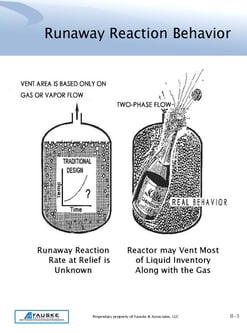Process Safety Management and 5 Reasons to Use Scare Tactics
"Communication that stimulates emotion will bring about more behavior change than communication that relies on reason. Emotion, not reason, drives behavior change."
 Chemical Engineering Progress (CEP) published an informative piece "Use Scare Tactics to Communicate Major Incidents" in its August issue. According to authors Renato Prestes and Dr. TJ Larkin, "Fear appeals are not unprofessional. Many engineers are uncomfortable with fear appeals because they are trained to prefer a 'just-the-facts' approach to communication. When communicating major incidents, a purely factual or pragmatic approach makes it much more likely the same type of incident will happen again. While a fear appeal may seem unprofessional to engineers, it is standard practice among communication experts. The just-the-facts approach, which is essential to good engineering, is the wrong approach for communicating major incidents."
Chemical Engineering Progress (CEP) published an informative piece "Use Scare Tactics to Communicate Major Incidents" in its August issue. According to authors Renato Prestes and Dr. TJ Larkin, "Fear appeals are not unprofessional. Many engineers are uncomfortable with fear appeals because they are trained to prefer a 'just-the-facts' approach to communication. When communicating major incidents, a purely factual or pragmatic approach makes it much more likely the same type of incident will happen again. While a fear appeal may seem unprofessional to engineers, it is standard practice among communication experts. The just-the-facts approach, which is essential to good engineering, is the wrong approach for communicating major incidents."
This is great reminder of human behavior. We talk ad nauseum about OSHA process safety management programs (PSM), and process hazards analysis (PHA) including:
- Auditing, reporting and presenting
- Gap assessment to identify and prioritize needs
- Process validation
- Safe scale-up guidance
- Development report documentation
- Consulting on process safety issues for change control MOC (management of change)
- Hazard and operability (HAZOP) analysis, what-if, checklists,
- Failure modes and effects analysis (FMEA)
- Quantitative risk assessments such as layer of protection analysis (LOPA)
But, an illustrative depiction of an actual accident goes a long way in prevention. When an incident occurs at a chemical process industries (CPI) facility as well as any industrial plant, shock and fear following the event may only last a few years unless you were directly involved. A direct graphic depiction, however, keeps the emotional aspect of the event triggered into active behavior. So, how?
- Streamline the image, make it clear with little copy. Simple, before and after images work well. Photos or streaming video work best, followed by illustrations.
- Be sure the image presents a problem/accident but also a solution. Illustrate simple steps that should occur to prevent this from happening again. An internet search of incidents on sites such as the Chemical Safety Board can produce many posters or images, but it is a lot harder to find one depicting an accident with a solution in one image.
- Deliver the presentation of these images in person, face to face. The impact of face to face review and discussion has much higher impact than emails or posting on walls unannounced.
- Avoid "poor taste" resistance feedback by managers or staff with a clear discussion of the importance of the impact their emotions have in this case. Use logic to make the case for emotion. Go for discomfort, not gore. The goal is to evoke moderate amounts of fear, otherwise, you've gone too far and behavior change will diminish.
- Per the article, "Communicating major incidents (e.g.,explosions, fires, large spills, multiple injuries, fatalities) is the most appropriate place to begin using fear appeals. Begin building a fear appeal communication as soon as the formal investigation ends."
 As a nuclear and process safety engineering testing and consulting lab, we specialize in severe accident management in all industries. Our work following Fukushima as well as ongoing nuclear plant D&D and plant services, combustible dust testing, thermal hazards, flammability and relief system design across industries has mitigated and helped to prevent accidents. We use illustrative posters in lab areas for our own employees as does our parent company Westinghouse Electric Corporation. We recommend you do as part of your PSM program.
As a nuclear and process safety engineering testing and consulting lab, we specialize in severe accident management in all industries. Our work following Fukushima as well as ongoing nuclear plant D&D and plant services, combustible dust testing, thermal hazards, flammability and relief system design across industries has mitigated and helped to prevent accidents. We use illustrative posters in lab areas for our own employees as does our parent company Westinghouse Electric Corporation. We recommend you do as part of your PSM program.
If you want more Process Safety Content click the button below!

